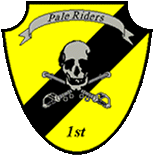
Botlrokit@yahoo.com
| Tactics |
This is by no means a comprehensive listing of the Pale Rider's repertoire, but only outlines of three general tactics that the regiment commonly uses.
Generally when a squadron or troop is advancing on an enemy position,
actively searching for an enemy position, or raiding behind enemy lines,
each cavalry troop's recon and scout platoons are deployed anywhere
from one to five kilometers in advance of the main group, with elements
of the 4th Air Cav Squadron ranging even farther ahead. The spacing of the individual recon/scout units varies with differences in terrain. At this point
the main objective is to detect the enemy while remaining undetected themselves.
If enemy recon units are detected they will usually
either discretely observe and report the enemy's movement, or engage taking
advantage of surprise and massive amounts of interlocking fire to try to
destroy them before they can report to their superiors. Once the
main objective (or obstacle) is detected the recon and scout platoons will
usually either call in an artillery strike, or observe and report the enemy's
movement or activities while the rest of the squadron or troop maneuvers
into optimal position to engage.
When the attack commences, the recon and scout platoons
form up at the flanks of the cavalry troop or troops and serve as fire support. The squadron's Heavy Mech Company is usually kept in reserve
until needed. This entire time, the elements the 4th Air Cav Squadron
are constantly providing Close Air Support (CAS), usually targeting "soft"
targets, such as infantry or vehicles, over mechs. The 4th Air Cav elements also provide infantry support should the need arise.
If, in this case, the 1st Volunteer ACR or one of it's squadrons is serving as forward screen for an advancing division or regiment respectively, it is likely that the Pale Riders will make contact with an enemy force much larger than their own. Should this happen (either on purpose or otherwise), the 1st Volunteer will attempt to hold the enemy unit or units at arms length until the friendly forces pass through and destroy them.
When serving a defensive role, the scout and recon platoons are again positioned well in advance of the main group. Generally they are in dug in positions prepared by the squadron's engineering vehicles, assuming they had enough time beforehand. When the enemy is detected, its recon units are again targeted and eliminated first. When the enemy's main unit comes within range of the Pale Rider recon and scout platoons, they begin to "shoot and scoot", firing from their positions until it is time for them to quickly withdraw to another prepared position, all the while reporting the enemy's movements and activities, and possibly calling artillery fire. The recon/scout platoons continue to trade space for time in this manner until the rest of the squadron or troop engages the enemy. At this point the recon/scout platoons again take up flanking positions and provide fire support. Again 4th Air Cav Squadron provides CAS and infantry support during the entire battle.
One very effective (and risky) means of devastating an enemy's command,
communications, and supply structure (not to mention moral) is the Artillery
Raid. All three of the Pale Rider's cavalry squadrons are quite familiar
with this tactic, but the 2nd ACS has refined it into an art form.
During a typical artillery raid a 1st Volunteer cavalry squadron's artillery
battery, along with one cavalry troop and elements of the 4th Air Cav,
dashes behind enemy lines and sets up at a pre-designated location usually
six kilometers from the enemy target. All eight of the artillery battery's Templars then
fire five shells each at the target with the help of forward observers inserted before to the raid. By the time the last shell falls, the
raiding party is already on its way to a second pre-designated location where
they will await confirmation of the target's destruction by the forward
observers. If the first volley has destroyed the target, then the
unit egresses to friendly territory. If the target is not destroyed,
then a second volley is fired and so on.